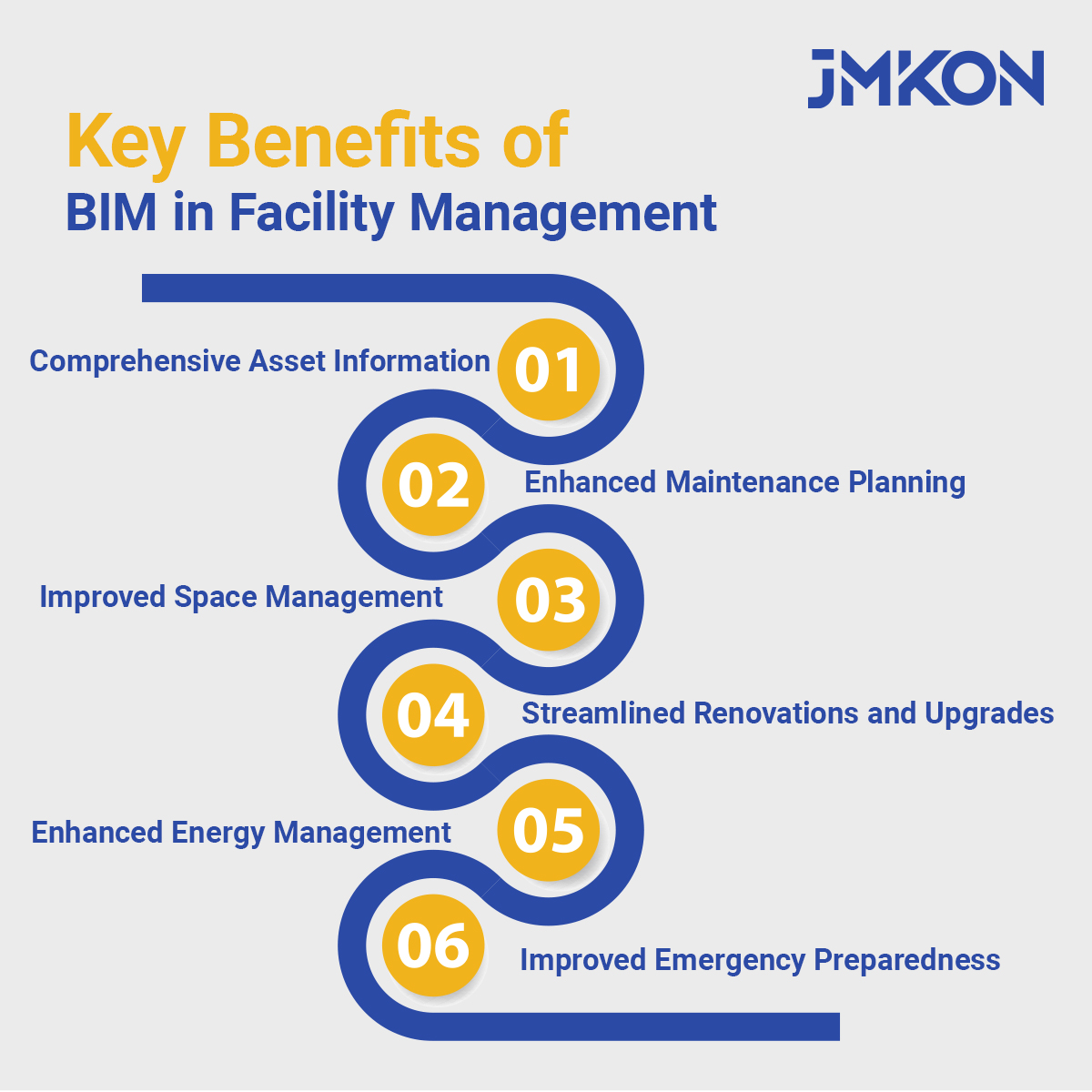Using BIM in Facilities Management is a transformative approach that we embrace at JMKON LLC. We understand that Building Information Modeling (BIM) is more than just a design and construction tool; it is a game-changer for facility management. Leveraging BIM enables us to manage, maintain, and optimize buildings throughout their entire lifecycle, from construction to facility operations, ensuring superior performance, sustainability, and efficiency.
What is BIM for Facility Management?
BIM for Facility Management provides a centralized, real-time platform that stores all essential building data. This allows facility managers, BIM managers, and other stakeholders to efficiently manage building systems such as HVAC, lighting, and plumbing. Whether it’s for asset management, space optimization, or energy efficiency, BIM streamlines operations and improves decision-making.
Learn more about: Benefits of building information modeling
Key Benefits of BIM in Facility Management

We will discuss how BIM is used in facilities management and explore its advantages in enhancing facility operations.
- Comprehensive Asset Information
Using BIM in facilities management provides a detailed and accurate digital record of the building’s assets, including mechanical, electrical, and plumbing systems. This information is crucial for maintenance planning, repairs, and upgrades, ensuring that facility managers have all the data they need at their fingertips.
- Enhanced Maintenance Planning
With BIM facility management, facility managers can plan maintenance activities more efficiently. The digital model includes information on the lifespan of various components and systems, allowing for predictive maintenance schedules that prevent unexpected failures and extend the life of the building’s assets.
- Improved Space Management
BIM facility management helps in optimizing space utilization within a building. Facility managers can use the digital model to analyze current space usage, plan for future needs, and adjust to improve efficiency and functionality.
- Streamlined Renovations and Upgrades
When it comes time for renovations or upgrades, BIM facility management provides a clear and comprehensive view of the existing building conditions. This reduces the risk of errors and unforeseen issues during construction, ensuring that projects are completed on time and within budget.
- Enhanced Energy Management
BIM can be used to monitor and manage the building’s energy use more effectively. By integrating energy consumption data with the digital model, facility managers can identify areas for improvement and implement energy-saving measures, reducing operational costs and environmental impact.
- Improved Emergency Preparedness
BIM aids in emergency preparedness by providing detailed information on the building’s layout, including exit routes, fire suppression systems, and emergency equipment locations. This information is critical for developing and implementing effective emergency response plans.
The Role of Digital Twin in Facility Management
A Digital Twin is a dynamic digital replica of a physical asset or system that plays a significant role in facility management by enabling real-time monitoring, predictive maintenance, and informed decision-making.
With real-time data from building systems like HVAC, electrical, and plumbing, facility managers can detect and resolve issues before they escalate, reducing downtime and costs. Additionally, the data allows for predictive maintenance by forecasting equipment failures, enabling proactive repairs. Digital
Twins also support informed decision-making by simulating various scenarios, such as energy optimization or space reconfiguration, without disrupting actual operations. Moreover, they offer detailed asset tracking, helping managers plan repairs or replacements effectively.
Digital Twins also enhance energy efficiency by monitoring consumption patterns, identifying inefficiencies, and implementing sustainability measures. Overall, they allow for continuous operational optimization, ensuring that building systems perform efficiently throughout their lifecycle.
Learn more about: BIM’s role in Construction Industry
BIM Standards and Data Transfer in Facility Management
BIM standards play a crucial role in ensuring consistency, interoperability, and data integrity across various systems in facility management. By adhering to established standards like ISO 19650 and COBie (Construction Operations Building Information Exchange), facility managers can efficiently transfer and utilize data throughout a building’s lifecycle. Here’s how BIM standards and data transfer impact facility management:
- Consistency and Interoperability
- Efficient Data Transfer
- Long-Term Data Accessibility
- Improved Asset Management
- Compliance and Reporting
BIM standards and data transfer protocols streamline the flow of information across the entire facility lifecycle, from construction to ongoing management, ensuring interoperability, efficiency, and long-term data integrity.
How JMKON LLC Uses BIM for Facility Management

At JMKON LLC, we utilize BIM to deliver superior facility management services. Our team uses BIM to:
- Maintain Detailed Records: We keep comprehensive digital records of all building assets and systems.
- Plan Predictive Maintenance: We use BIM to schedule maintenance activities, reducing downtime and extending asset life.
- Optimize Space Use: We analyze and plan space usage to improve efficiency and functionality.
- Facilitate Renovations: We provide accurate information for renovations and upgrades, minimizing risks and costs.
- Manage Energy Use: We monitor and optimize energy consumption, reducing operational costs.
- Enhance Safety: We develop and implement emergency response plans using detailed building information.
Common Misconceptions of BIM: JMKON Sets the Record Straight
BIM is transforming facility management, and at JMKON LLC, we are committed to using this technology to improve the management and maintenance of buildings. By embracing BIM, we can deliver better results, faster and more efficiently.
For more information on how JMKON LLC can help you with your facility management needs using BIM, contact us today!





